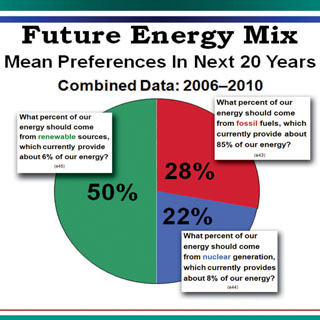Annual survey tracks evolving attitudes about national security issues

More than three-quarters of respondents in a recent national survey said they believe today’s world is a more dangerous place for the US than it was during the Cold War. The same survey found that in the past year Americans perceive the effectiveness of security efforts at US airports, seaports, and the nation’s borders is declining. The survey also found that within the next 20 years, Americans would prefer to see an energy mix comprising 50 percent renewable energy sources (currently 6 percent), 28 percent fossil fuels (currently 85 percent), and 22 percent nuclear generation (currently 8 percent).
The findings come from the 2010 National Security Public Attitudes Project, conducted by principal investigators Hank Jenkins-Smith, Kerry Herron, and Carol Silva of the Center for Applied Social Research (CASR) at the University of Oklahoma. Conducted since 1993, this unique annual study assesses Americans’ attitudes toward a broad range of national security issues. Sandia cofunds the study with the University of Oklahoma and uses the results to help inform its mission areas.
Results of the latest survey were presented at Sandia in late October.
“Although we, as Sandians, are immersed in elements of national security in real and tangible ways, it is important to keep in mind that the public’s attitudes and understanding of issues play an essential role in setting national policy,” says Lori Parrott, manager of Strategic Studies Dept. 552. “For example, the public plays a key role in shaping national security priorities and outcomes. Understanding the public’s perceptions of their safety and security, as they relate to dimensions of national security, assists us in understanding how best to inform national debate.”
The National Security Public Attitudes Project is a unique study in two significant ways. No other study has been conducted over as long a period of time, and no other study covers as broad a scope of national security topics.
“While similar studies focus on public attitudes toward specific topics, the National Security Public Attitudes Project assesses attitudes toward many dimensions of energy security, nuclear security, and the threat of terrorism,” Lori says. “Its scope allows us to generate a much more complete view of how the public perceives national security.”
With regard to energy security, the study’s 2010 results revealed that respondents’ confidence in the nation’s energy future is on an upward trend, increasing from 5.01 in 2008 to 5.63 (on a Likert-type scale, with 1 meaning “not confident at all” and 10 meaning “completely confident”). Further, respondents reported that the most important prospective energy technology R&D would be in areas of solar, wind, and hydro energy, while they ranked clean coal, nuclear energy, and oil and gas as least important for investment.
Shifting to the second portion of the study, public attitudes on nuclear security mirror the complexity of the issue. While many respondents consider nuclear abolition to be desirable, 80 percent do not think it is feasible.
According to the study’s results, 73 percent of respondents believe that “the US nuclear arsenal deters attacks and ensures our security, and that these benefits far outweigh any risks from US nuclear weapons.” Further, a large majority does not want the US to have fewer nuclear weapons than any other country and eight out of 10 people reject unilateral US nuclear disarmament.
Respondents said they believe nuclear weapons are relevant for deterring other countries from using nuclear weapons against the US, deterring other countries from providing nuclear weapons or material to terrorist groups, and for helping maintain US international influence, status, and military superiority. However, a nearly even split emerged concerning the effectiveness of the US nuclear arsenal in deterring the use of weapons of mass destruction by terrorists and nonstate actors, with 51 percent perceiving great utility and 49 percent perceiving little utility).
In addition to issues related to nuclear weapons and energy policy, the 2010 National Security Public Attitudes Project also questioned respondents about the threat of terrorism. Although predictably peaking right after the Sept. 11 attacks, respondents’ average assessment of the overall threat of terrorism in the US has declined approximately 16 percent over the years, though currently remaining well above pre-Sept. 11 assessments (7.55 on a Likert-type scale with 0 meaning “no threat” and 10 meaning “extreme threat”).
Respondents indicated midscale confidence in the US government to prevent terrorist attacks in the US, with a score of 5.01 on a Likert-type scale, with 1 meaning “not confident at all” and 10 meaning “completely confident”), as well as midscale confidence in the nation’s ability to accurately assess threats of terrorism both at home and abroad (4.77 in US and 4.46 abroad).
The 2010 survey also probed respondents’ opinions about measures designed to mitigate the threat of terrorism. The top measures for which respondents reported tolerance were restricting immigration (70 percent), requiring national identification cards (60 percent), and monitoring telephone calls (49 percent). The areas of least reported tolerance were monitoring behaviors (54 percent), taking unauthorized photos (55 percent), and sampling DNA (50 percent). Tolerance for trading personal liberties for increased levels of security increases with age, political conservatism, and perceptions of the terror threat.